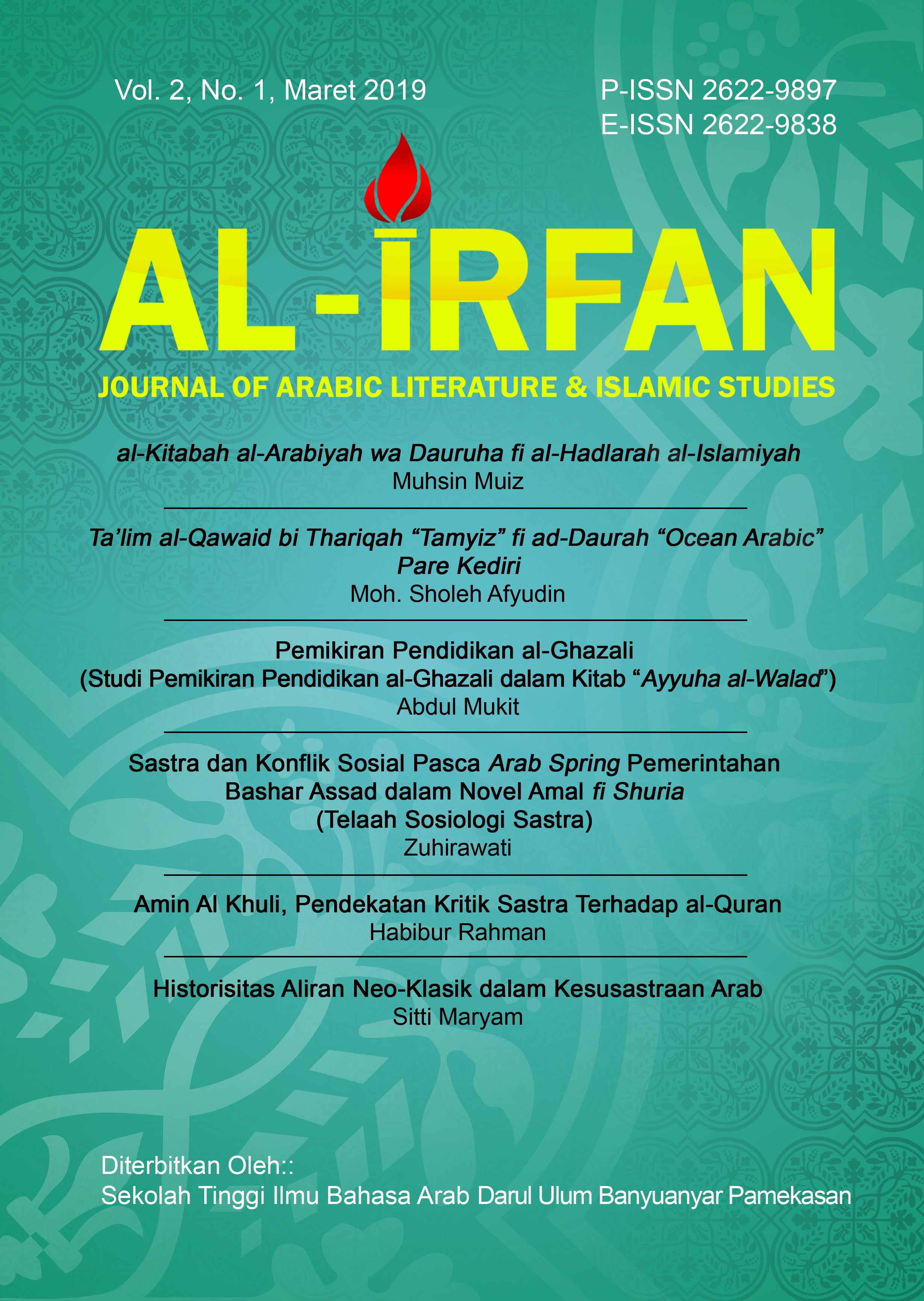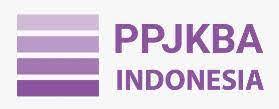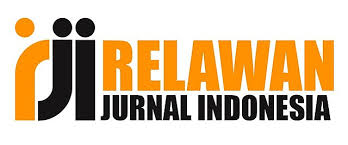Ta'lim al-Qawaid bi Thariqah Tamyiz fi al-Daurah Ocean Arabic
DOI:
https://doi.org/10.58223/al-irfan.v2i1.485Keywords:
Teaching Grammar, Grammar, Tamyiz MethodAbstract
In fact, theteachingof Arabic grammar had many problems, including: no interesting of students towards these subjects and the learning takes a long time. There are those who argue that grammar should not be studied specifically so that students will take it as a primary goal. Then one of the characteristics of grammar is in need of memorizing and analyzing strengths, this gives a negative thought that grammar is a difficult subject. Probably, those negative facts due to the absence of teaching methods that can make it easier, because the difficult subject is to definitely need an easy method. Tamyiz method tries to plant the thought that grammar is easy and fun, because the subjects and the activities inside composed of songs, applause, symbols and magic formula (mantra), so that it makes it easier for students to remember and memorize. It is interesting to study deeper in Ocean along the students who are generally adult, and, indeed,the differentstudents demandsthe different strategies. Tamyiz method colored with various movements of childhood that are not duly presented to adult students, but applying it to the adult students will need a special character of teachers, so that even the students are adults deign to follow the songs and all the contents of Tamyiz method. This research is a descriptive study using a qualitative approach. The data were collected through observation in the field, interviews and documentation. The method of analysis is using the method formulated by Miles &Huberman . The results of this research are : 1) Description of teaching grammar by Tamyiz method consists of learning objectives, the student is able to translate the Holy Quran, but it is not the understandable translation, but it is closer to the understanding of the meaning of the Holy Quran. Practice, such as songs, symbols, mantraand practices to translate the Holy Quran can help students in strengthening of understanding and memorizing subjects. In addition, the subjects are also arranged in a form easily to be memorized and understood. There are also some differences between the subjects of Tamyizand the subjects on ancient Arabic grammar, which aims to simplify. 2) The positive effects of this teaching are: 1) to plant the thoughts that grammar is an easy subject 2) students will be able to teach after they finish studying 3) learning grammar easily 4) understanding of the meaning of the Quran in the student’s futures.
References
Abaza, T. (2011). Tamyiz; Anak kecil saja bisa, yang pernah kecil pasti bisa. Jakarta: Tamyiz Publishing.
ʿAbd al-ʿAlīm, I. (1968). al-Dawru al-fatḥī li-tadrīs al-lughah al-ʿArabiyyah. al-Qāhirah: Dār al-Maʿārif.
ʿAbd al-ʿAzīz ibn Ibrāhīm al-ʿUṣaylī. (1999). al-Naẓariyyāt al-lughawiyyah wa al-nafsiyyah wa taʿlīm al-lughah al-ʿArabiyyah. al-Riyāḍ: Jāmiʿat al-Imām Muḥammad ibn Saʿūd al-Islāmiyyah.
ʿĀbid Tawfīq al-Hāshimī. (1983). al-Dawru al-ʿamalī li-tadrīs al-lughah al-ʿArabiyyah. Bayrūt: Muʾassasat al-Risālah.
Arsyad, A. (2010). Bahasa Arab dan metode pengajarannya: Beberapa pokok pikiran. Yogyakarta: Pustaka Pelajar.
Burdah, I. (2004). Menjadi penerjemah: Metode dan wawasan menerjemah teks Arab. Yogyakarta: Tiara Wacana Yoga.
Buzān, T. (2009). al-Kitāb al-amthal li-kharāʾiṭ al-ʿaql (Tarjamah Maktabat Jarīr). al-Riyāḍ: Maktabat Jarīr.
Cahyono, B. E. H. (2016). Sugestopedia: Pendekatan pengajaran bahasa kedua yang bersifat humanistik. FPBS IKIP PGRI Madiun. Retrieved from http://e-journal.ikippgrimadiun.ac.id (Accessed on May 11, 2016).
Creswell, J. W. (2014). Penelitian kualitatif & desain riset. Yogyakarta: Pustaka Pelajar.
Dryden, G., & Vos, J. (2002). Revolusi cara belajar: Belajar akan efektif kalau Anda dalam keadaan fun (Word ++ Translation Service, Trans.). Bandung: Penerbit Kaifa.
Ḥamūd, A. al-Sayyid. (1988). al-Lughah.. Tadrīsan wa-iktisāban. al-Riyāḍ: Dār al-Fayṣal al-Thaqāfiyyah.
Hidayatullah, S. (2014). Seluk-beluk penerjemahan Arab-Indonesia kontemporer. Jakarta: alkitabizz.
Khunaifi, A. R. (2015). Penggunaan metode sugestopedia dengan musik klasik terhadap minat belajar bahasa Inggris. Pedagogik Jurnal Pendidikan, 10(2), Oktober.
Mitchell, R., & Myles, F. (2004). Naẓariyyāt taʿallum al-lughah al-thāniyah (Tarjamah ʿĪsā ibn ʿAwdah al-Sharīfī). al-Riyāḍ: Jāmiʿat al-Malik Saʿūd.
Mounaff, G. (1994). al-Masāʾil al-naẓariyyah fī al-tarjamah (Tarjamah Laṭīf Zaytūn). Bayrūt: Dār al-Mukhtār al-ʿArabī.
Muin, A., et al. (2011). Efektivitas ilmu nahwu dalam pembelajaran bahasa Arab: Studi kasus di MAS Simbang Kulon Pekalongan. Jurnal STAIN Pekalongan, 8(1), Mei.
Nufus, H. (2013). Pembelajaran gramatika Arab dengan communicative grammar. Jurnal Studi Islam, Pascasarjana IAIN Ambon, 1(1), Januari-Juni.
Rizāf, I. (2013). Istikhdām ṭarīqat al-tamyīz li-taʿlīm al-qawāʿid al-naḥwiyyah wa-atharuhā fī taḥṣīl al-ṭullāb (Master’s thesis, Jāmiʿat Maulānā Mālik Ibrāhīm al-Islāmiyyah al-Ḥukūmiyyah, Malang, Indonesia).
Sugiyono. (2013). Metode penelitian kuantitatif, kualitatif dan R&D. Bandung: Alfabeta.
Downloads
Published
How to Cite
Issue
Section
License
Copyright (c) 2019 Moh. Sholeh Afyudin

This work is licensed under a Creative Commons Attribution 4.0 International License.
Lisensi :
Al-Irfan: Journal of Arabic Literature and Islamic Studies is published under conditions Creative Commons Attribution 4.0 International License / CC BY 4.0 This license permits anyone to copy and redistribute this material in any form or format, modify, modify, and make derivative works of this material for any purpose, including commercial purposes, so long as they credit the author for the original work.











